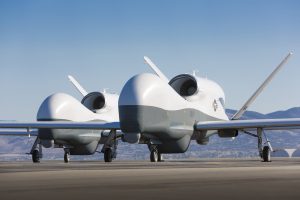For the first time, the U.S. Navy has deployed two MQ-4C Triton unmanned aerial system (UAS) to Andersen Air Force Base on the U.S. territory of Guam in the western Pacific. The MQ-4C is currently in limited service with the U.S. Navy and the deployment to Guam marks the first time the system has been available for missions in the western Pacific.
“The inaugural deployment of Triton UAS brings enhanced capabilities and a broad increase in maritime domain awareness to our forward fleet commanders,” the commander of the U.S. Navy’s Patrol and Reconnaissance Group, Rear Adm. Peter Garvin, said in a statement.
“VUP-19, the Navy’s first dedicated UAS squadron supported by an outstanding NAVAIR (Naval Air Systems Command) and industry team, is superbly trained and ready to provide the persistent ISR coverage the Navy needs,” he added.
The MQ-4C Triton is an unmanned aerial vehicle (UAV) designed to conduct high-altitude long-endurance (HALE) intelligence, surveillance, and reconnaissance (ISR) missions for the U.S. Navy. The system is based on the older RQ-4 Global Hawk HALE UAV.
According to Northrop Grumman, the manufacturer of the MQ-4C, the system has a mission endurance of more than 24 hours and is capable of operating at altitudes in excess of 10 miles. The MQ-4C’s operational range is 8,200 nautical miles, which would give it a considerable capability to carry out a range of missions in the Western Pacific.
The range and endurance of the MQ-4C would allow it to participate in ISR missions as far as the East China Sea, the Korean Peninsula, and even the South China Sea — all areas of interest for the U.S. Navy’s Pacific Fleet.
The deployed MQ-4Cs are unlikely to see serious use until the program reaches initial operational capability, which is expected in 2021. Currently, the MQ-4C program represents an early operational capability, meaning that the system is available for use, but has not yet met all the benchmarks required for IOC status.
The MQ-4Cs based in Guam will be available for use by Task Force 72, which is based out of Misawa, Japan. The Commander of Task Force 72 (CTF 72) “leads patrol, reconnaissance and surveillance forces in support of U.S. Seventh fleet,” according to a U.S. Navy statement.
CTF 72 is charged with the promotion of “regional security and enhancement of theater security operations through multilateral engagements to build, reconnaissance and surveillance capability within SEVENTH fleet and partner forces,” according to its mission statement.
In 2019, the U.S. Department of Defense’s Indo-Pacific Strategy Report identified the region, which runs from the western coast of India to the western coast of the United States, as Washington’s “priority theater.”

































